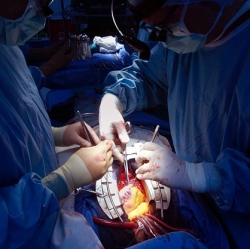
University at Buffalo researchers are developing a new imaging technique using nanoparticles suspended in liquid to form “nanojuice” that patients would drink to help diagnose irritable bowel syndrome, celiac disease, Crohn’s disease and other gastrointestinal illnesses.
Doctors would strike the nanoparticles, once they reach the small intestine, with a harmless laser light, providing an unparalleled, non-invasive, real-time view of the organ. Described July 6 in the journal Nature Nanotechnology, the advancement could help doctors better identify, understand, and treat gastrointestinal ailments.
Located deep in the human gut, the small intestine is not easy to examine. X-rays, MRIs and ultrasound images provide snapshots but each suffers limitations. “Conventional imaging methods show the organ and blockages, but this method allows you to see how the small intestine operates in real time,” said corresponding author Jonathan Lovell, PhD, UB assistant professor of biomedical engineering.
“Better imaging will improve our understanding of these diseases and allow doctors to more effectively care for people suffering from them.” The average human small intestine is roughly 23 feet long and 1 inch thick. Sandwiched between the stomach and large intestine, it is where much of the digestion and absorption of food takes place. It is also where symptoms of irritable bowel syndrome, celiac disease, Crohn’s disease. and other gastrointestinal illnesses occur.
To assess the organ, doctors typically require patients to drink a thick, chalky liquid called barium. Doctors then use X-rays, magnetic resonance imaging, and ultrasound to assess the organ, but these techniques are limited with respect to safety, accessibility and lack of adequate contrast, respectively.
